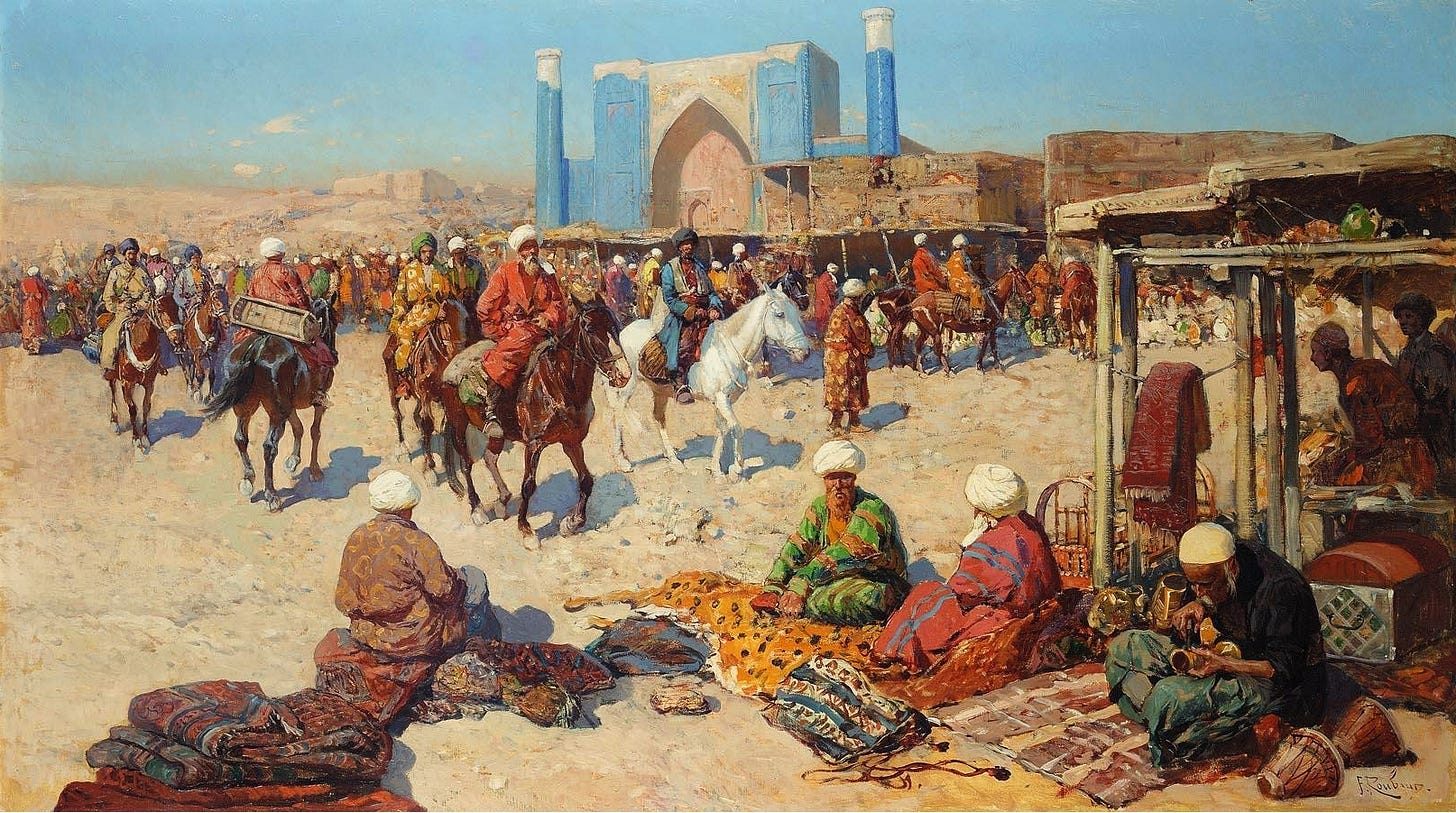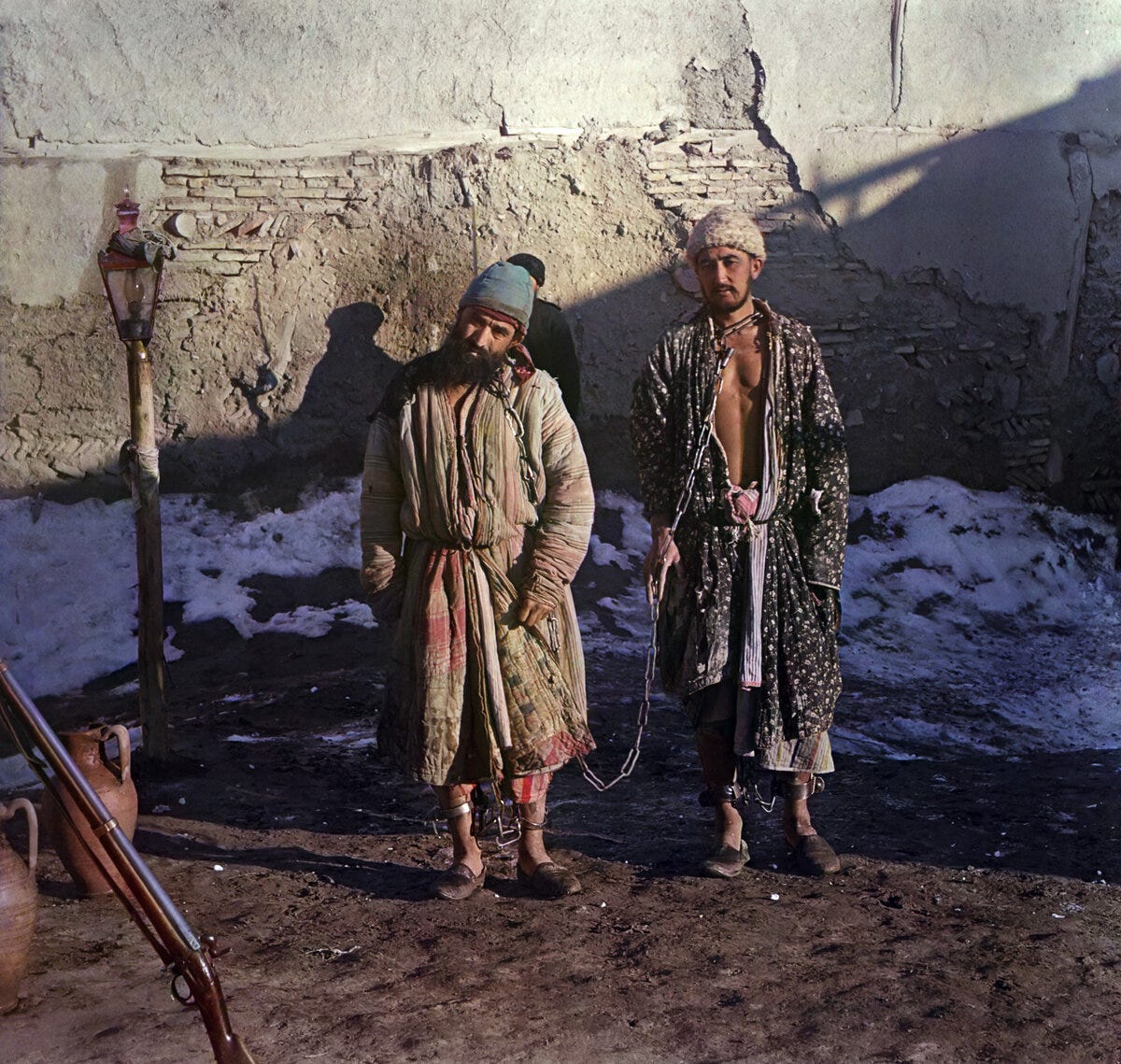Slaves in Khiva - Mikhail Kachenovsky, 1815
Translation about the slaves of Khiva, from "The Expedition to Khiva"
Below is one of the appendices from “The Expedition to Khiva” by Maksud Alikhanov-Avarsky, the book which I have translated and published. Along the book itself, I also included a 15,000 word introduction and 9 additional translations as appendices. My post introducing the book can be found here. I have republished this appendix here for promotional purposes.
“The Expedition to Khiva” is a memoir by Maksud Alikanov-Avarsky, a Dagestani officer who was a part of the general staff of the Russian Caucasus detachment during the 1873 conquest of the Khanate of Khiva in Central Asia.
The book is available on Amazon, in paperback and on Kindle. Buy it now!!!
APPENDIX A - Slaves in Khiva
Mikhail Trofimovich Kachenovsky, Vestnik of Europe, Part 80. 7. 1815
Невольники в Хиве // Вестник Европы, Часть 80. № 7. 1815
Translator’s Introduction
Below is an article from the biweekly journal “Vestnik of Europe” which ran from 1802 to 1830. The journal published articles that covered a variety of subjects, including politics, history, literature and art. The author, Mikhail Trofimovich Kachenovsky, served as the journal’s editor and publisher. Kachenovsky was born in 1775 in Kharkov to a family of Greek wine merchants originally from Balakava on Crimea. He served as an uryadnik in the Ekaterinoslav (modern Dnepropetrovsk) Cossack militia, later as a state official in Kharkov, and then held other minor military posts elsewhere. After serving as a librarian to Graf Alexey Kirillovich Razumovsky, he was given a doctorate in philosophy and later worked at the Imperial Moscow University and the Moscow Noble University, where he taught arts, diplomacy and history.
Slaves in Khiva
Kyrgyz who thievish invade the frontiers of Russia, and Turkmen on the Persian frontier, kidnap large numbers of subjects from both of these States, and then sell them as slaves to the Khivans, who, due to their location between Russia, Persia and Bukhara, for some time have made for themselves a great profit in the trade of this theft. Without them as an intermediary, this thievery would not have had such success and spread so widely; had the Kyrgyz not always have had ready and generous buyers among the Khivans, they would not try to so greedily take captives, since they keep so few slaves themselves. The Bukharans are not particularly willing to take part in this trade, and especially not in the sale of Russians. It can be assumed that the Khivans and Konrats1 have more than 15,000 Russian captives. This number is mostly made up of whole families who were captured by the Kyrgyz during the former period of chaos2 in the Astrakhan Governorate.
Persian captives, who are called Kizalbashi by the Khivans, greatly outnumber the Russians. Masters have so much power over these slaves that he can kill them without having to give any account for why.
The typical work of slaves includes: 1) Manure and cultivate arable land, vegetable gardens and orchards. The soil is tilled by two oxen with a small plow; in the cities they dig with pickaxes. 2) Sowing and harvesting grain; in the cities plant vegetables, harvest trees in the orchards; clean canals and waterways, release water from them for irrigation. 3) Grind flour daily with a hand millstone and pound cereal with a mortar and pestle. 4) Make carts and agricultural tools; simply, to bear all domestic burdens. This keeps the captives continuously occupied so that they do not have the slightest amount of leisure time during the day, except for a few minutes for fortifying themselves with nourishment and a few hours to rest when asleep. The slightest error in their assigned work is punished cruelly.
The food of these sufferers consists of two thin flatbreads a day, sometimes gruel, and very rarely a small piece of meat. They are allowed to eat vegetables and fruits only when they begin to spoil. Their clothing is one shirt a year and two robes. They are rarely given shoes, and when they are given them, they are worn out. Their beds are made from straw and reed. Most of all, slaves are forbidden to have any sort of weapon with them; they are not even allowed to have knives.
Three times a year during bairams3 slaves are given freedom for two days; only during this time can they see one another. There are slaves, particularly Russian ones, who have accumulated enough money to buy their own things. They have their own homes, but they do not have complete freedom. They are given a few exemptions from work, but their property is always considered to be a part of their master’s estate.
The ransom and removal of captives from Khiva, Russians in particular, is always done without the awareness of the local authorities, as they strictly forbid this.
Enslaved Russians and Persians are always friendly among each other, and are naturally the first enemies of the Khivans. Turkmen and Karakalpaks also have slaves. Moreover, in Khiva and Konrat there are many fugitive Russian soldiers from among the Tatars.
A reference to the Mongolian tribe Khongirad, whose origins lie in Inner Mongolia near Manchuria. During the Yuan Dynasty (1217-1368), Khongirads began migrating into Central Asia and eventually their descendants founded the ruling dynasties of Khiva, Bukhara and Kokand, as well as some noble family among the Kazakhs, specifically among the Middle and Big Hordes. The usage of this word here likely refers to the Kazakhs of the Middle Horde.
This likely refers to the Pugachev Rebellion from 1773 to 1775, a jacquerie lead by a Cossack who claimed to be the Tsar, which ravaged the lower Volga region during the reign of Catherine the Great.
Holidays and celebrations.







I wonder when Kachenovsky visited Khiva because Pugachev's rebellion was 40 years prior to the publishing of this article and I doubt many slaves captured then would have been alive after so long.
The internet says he graduated college in 1789 and was editor of Vestnik of Europe after 1805 so I would guess the 1790's.
Prokudin-Gorsky's photos always blow my mind.
Sound really interesting. The frontiers of the Russian empire are such an exotic world that, though real of course, they have the mystique of a fictional world.